
 |
||||||
| Author Interviews | Horror Book Resources | Librarian Resources | Contact Us |
|
||
The Monster Librarian Presents:
Horror Magazines and Serials
The following are magazines and serials that are dedicated to horror fiction that often include short stories, poems, reviews, and other items.
 Absalom's
Wake Part Two: Blood on the Beach
by Nancy A. Collins*New Review
Absalom's
Wake Part Two: Blood on the Beach
by Nancy A. Collins*New Review
Biting Dog Publications, 2012
ASIN: B00ASBEDYU
Available: eBook(Kindle, Nook, Smashwords)
Absalom's Wake Part Two: Blood on the Beach picks up where Part One: Gone A' Whaling left off. After harvesting the whale from part one, Jonah and the remaining crew of Absalom's Wake returns to their quarters to rest and to mourn the passing of their mates who were not so lucky in the hunt. After fifteen months at sea, they head for the tropical island paradise of Taiohae Bay for rest and to repair their ship. The moment they drop anchor, the natives paddle out to greet them and ply their wares. Repairs go well, and the crew goes to the local watering hole, Toad Hole, for their reward. Toad Hole is the island's sole tavern, and caters to everyone, including cannibals. The cannibals’ one-eyed leader gives Jonah a venomous glare for some unknown reason. After drinking the day and evening away, Jonah and his friends go to sleep on the beach, only to be awakened by the sound of the cannibals killing his friend Santo. This episode ends with Jonah running down the beach with the cannibals hot on his heels!
This part of Ms. Collins’ tale is just as strong as part one was. All of the expected and desired elements of a great 1800's style ship adventure are here, plus twists and turns you don't see coming! The descriptions paint a vivid picture. I really got a strong sense of the environment and the characters. The tone is consistent and the plot moves right along. There is plenty of action, and enough suspense to keep a reader riveted to the end! I can't wait to read part three! Recommended for adult readers.
Reviewed by: Aaron Fletcher
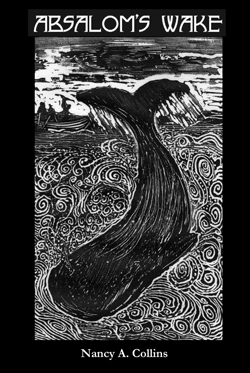 Absalom’s
Wake part 1 by Nancy Collins*New
Review
Absalom’s
Wake part 1 by Nancy Collins*New
Review
Biting Dog Publications, 2012
ASIN: B00AEVPJBK
Available: Free in various e-reader formats at Biting Dog Press here:
http://www.bitingdogpress.com/Bitingdogpub/free_ebooks/free_eBooks.htm
This is a fantastic tale of a young man enamored of tales of the sea told by his beloved uncle, a retired sailor himself. Set in 1846, we follow Jonah Padgett’s path as he recollects leaving his childhood home near Philadelphia after his beloved uncle's death to pursue life on the ocean. With a letter of recommendation from his uncle and a few prized possessions, Jonah lands a berth on board the whaling ship Absalom under the same captain his uncle had sailed under. Whaling is a thankless profession full of dangers amplified by the mysterious happenings of the sea. Jonah discovers life on board is brutally hard, but it is not without its compensations. He loves the sea, and that is enough to keep him going. Jonah describes the excitement and dangers of a whale hunt, and the disgusting, arduous task of rendering the blubber into oil. Taking a break from the work he wanders on deck to discover the sailors are not alone!
Ms. Collins' first part of six about a daring sea adventure does not disappoint. She starts us out by describing the harsh realities of life on a whaling ship in the mid 1800's. Her command of prose is superb! The descriptions are fantastic! You can feel the ocean breeze and smell the tang in the air. The action is riveting and moves the plot right along. Her use of dialects in the various characters’ speech adds a nice touch. I really liked the twist at the end and look forward to how the rest of the series develops. I have not read Nancy A. Collins’ work before, and I can't wait to read part two. Recommended for young adult and adult readers.
Contains: Not Applicable
Reviewed by: Aaron Fletcher
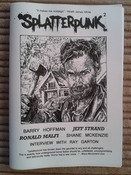 Splatterpunk
#2 by Jack Bantry*New Review
Splatterpunk
#2 by Jack Bantry*New Review
Splatterpunk zine 2012
Available:
http://splatterpunkzine.wordpress.com/
44 pages
Jack Bantry, editor of the cool little zine Splatterpunk 2 would like to debate the origins of the genre, whether or not it is a genre, and, anyway, the coining of the name. Horror has evolved steadily like every other literary form; writers and filmmakers have found it progressively harder to shock and thrill audiences, whether with sex or with blood. We just keep growing those thicker, chewier skins. I remember when Stephen King’s reanimated cat sent readers to bed with their lights on. 30 years later, Jeff Strand, in his flash-fiction “Fair Trade,” mutilates his mistress beyond recognition with a hammer and kitchen knife, and is then invited by his wife to have a ménage å trois with it. And that’s not the most graphic thing I’ve read lately, either.
It takes a very bold author to reach under that sticky psycho brain flap and feel around the murky sludge pool from whence comes shock lit. Our tolerance for progressively more graphic horror is definitely increasing; we’ve become jaded by routine exposure to gore over time. The popularity and financial success of intensely graphic horror aimed at young adults, (the New York Times bestseller-with-instantaneous-film-rights John Dies at the End comes to mind) is proof of the growth of the genre, and the growing appetites of the readership, especially for the comic stuff.
What’s great about this particular zine, is that it is a volume of interesting tidbits, essays and viewpoints, including an interview with veteran gore writer Ray Garton. Interesting artwork is separated by icky but engaging micro-fiction. Each story builds its tension artfully to a single climactic event of sudden, shocking violence, with one exception. Shane Mckenzie’s “Fat Slob” is a hilariously hideous way to regain one’s former fighting weight without diet or strenuous exercise. Original and inspired, disgusting and just weird, it’s my favorite in the collection.
I would like to discuss the reasons we (or at least I) laugh at scenes of eyeball gouging, brain eating, extraneous amputation, and drippy viscera plopping, but why ruin it? The zine’s a keeper, and a more formal printing would be justified and probably sell well. Furthermore, I like the name Splatterpunk. But really, by any other name, it would still smell sickly sweet, like a rotting corpse, picked clean of all the tender edibles, and set aside to ripen.
Contains: graphic violence.
Recommended for adults
Reviewed by: Sheila Shedd
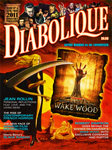 Diabolique
Magazine
edited by Robert J. E. Simpson
Diabolique
Magazine
edited by Robert J. E. Simpson
HorrorUnlimited, 2011
ISBN: N/A
Bimonthly, $9.98/issue
Available at: http://horrorunlimited.com/Magazine/ (subscription required)
Diabolique magazine is a new, bimonthly print/.pdf publication that focuses on horror movies made off the beaten path (i.e. European or independent). They had published four issues at the time of this submission; issues three and four were made available for review.
The colorful and detailed layouts of the magazine, designed by Dima Ballin, are executed quite well, and the juxaposition of the classic photos with modern backgrounds breathes new life into the black-and-white stills. The passion the staff has for horror films, especially those of European origin, is evident. The articles should be interesting and easy to follow for both neophytes and hardcore fans alike.
The articles primarily consist of observations about classic European movies, reviews of independent horror films, and expositions on the works of particular directors (i.e. Jean Rollin). They also have unique articles, such as a story describing ways producers and directors can incorporate social networking and technological media to involve their potential audiences in complementary, interactive events (“Pervasive Horror Entertainment” by Robert Pratten, fourth issue).
As a potential addition to the periodical section, the narrow concentration of Diabolique’s content is both its strength and its shortcoming. However, there is enough depth and quality to the writing that anyone who is a horror fan or interested in the film industry should find Diabolique magazine a good read. Recommended as a source for new movies for a film discussion group and/or where there is a large horror customer base.
Contains: explicit nudity, gore, depictions of violence
Reviewed by: W. E. Zazo-Phillips
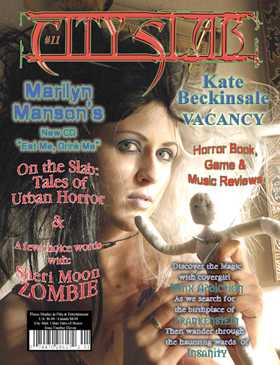 City
Slab (Issue #11) editor Dave Lindschmidt
City
Slab (Issue #11) editor Dave Lindschmidt
City Slab Publications
ISBN: 07447028617201
One of the things that makes City Slab stand out is its production quality. This general interest magazine for horror fans is printed in color on high gloss paper, and has a visual appeal that will even catch the attention of normally uninterested readers. City Slab covers typical topics of interest for its intended audience, including celebrity interviews and reviews for books, music, and movies. Issue #11, reviewed here, included an interview with Sherri Moon Zombie, a review of the film Vacancy, a number of horror fiction reviews, and a music review of the band Coil as well as one for the latest Marilyn Manson CD. The reviews are well done and provide useful insight into the material covered. City Slab also had interesting non-fiction articles such as Lisa Agnew’s “Frankenstein’s Genesis” which delves into Mary Shelley’s possible motivations in writing the story of Frankenstein and his famous monster, and “Bedlam Lobotomies” which looks into the history of lobotomies in psychiatric care. City Slab is produced quarterly and is distributed via Ingram Periodicals, Disticor Direct, Ubiquity Distributors, and Diamond Comics Distribution. Since it addresses a variety of topics and areas of interest, City Slab will appeal to a wider range of readers than horror magazines focused on only horror fiction and reviews, and can serve as a bridge to fiction for horror fans who are mostly interested in movies and music. Collection development note: Librarians may want to check out the reviews in City Slab before putting it into circulation. City Slab may get some people hooked on reading- so don’t be surprised if it walks off the shelf. Recommended. The magazine's website is www.cityslab.com.
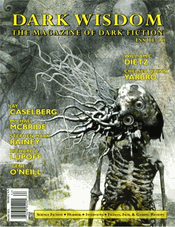 “Dark
Wisdom –The Magazine of Dark Fiction,” (Issue 10), ed. William Jones
“Dark
Wisdom –The Magazine of Dark Fiction,” (Issue 10), ed. William Jones
Elder Signs Press
ISBN: N/A
Magazines in the genre of dark fiction do not come any better. Dark Wisdom, produced by the staff at Elder Signs Press is first and foremost a work of beauty. The magazine is gorgeous, from the macabre artwork and heavy stock of the cover to the glossy full color interior pages. The content is even more compelling. Issue 10 features some brilliant Lovecraftian-inspired prose from some of the brightest names in the genre, including William Dietz, Kevin Anderson, and Gene O’Neill. The true stars, though, are veteran scribe Stephen Mark Rainey (whose “The Lake of Shadows” borders on perfection) and up-and-coming wordsmith Michael McBride (who serves up the fascinating The Generosity of Strangers). Filled with well-written editorials and features, including an interview with the legendary Chelsea Quinn Yarbro, “Dark Wisdom” is a tour-de-force.
Readers advisory note: Fans of H.P. Lovecraft in particular and dark fiction in general will love this magazine. It may also be of interest to graphic artists. A subscription is highly recommended for large public libraries serving a substantial community of aficionados of horror fiction and art. Contains: Adult language, Adult situations, Fantasy violence, Mental illness, Disturbing imagery
Review by Bob Freeman
 Cthulhu
Sex Magazine Volume 3 Issue 13
edited by Michael
Amorel
Cthulhu
Sex Magazine Volume 3 Issue 13
edited by Michael
Amorel
Cthulhu Sex Magazine,
2007
ISBN: 5422857345
Cthulhu Sex Magazine is a nice blend of horror stories, poetry, artwork, interviews and book reviews. The stories are horrifying, disturbing, and thoroughly entertaining. The magazine is also loaded with fantastic examples of black and white art. All of the artwork is excellent and like the stories the art is disturbing, fitting well with the tone of the magazine. Mixed in with the stories and art are also a few dark poems that really round the magazine out. Anyone who loves the Lovecraft Mythos and tales of tentacles and sensual horror will love this magazine for its dark and disturbing stories and matching works of art. At the end of the magazine are several good reviews of horror books that aren’t in the mainstream horror fiction. I would cautiously recommend Cthulhu Sex Magazine to most public libraries based on its excellent stories and fantastic art. I say cautiously because the magazine does have adult content and some aspects would be disturbing to casual readers. The magazine is well worth the $4.95 + S/H and can be purchased from Shocklines. Review by Bret Jordan
 Cemetery Dance
executive editor Richard Chizmar
Cemetery Dance
executive editor Richard Chizmar
Cemetery Dance Publications
ISSN: 10477675
A bi-monthly magazine that is dedicated to horror in various formats. Cemetery Dance magazine offers its readers short horror fiction, horror related movie reviews, horror fiction reviews, author interviews and a column on collecting modern horror books. In addition, the magazine also has a dedicated column to all things Stephen King. The magazine should be considered a basic cornerstone in a horror magazine collection and a good resource for Stephen King fans. The consideration is that some of the articles can contain adult language and some of the short stories may not be appropriate for all audiences. Cemetery Dance magazine is another good resource for current horror fiction reviews and can serve as a good place for those new to the horror genre to get their feet wet and become familiar with some of the authors of the genre. Recommended for public libraries.
 Bare
Bone #7 edited Kevin L. Donihe
Bare
Bone #7 edited Kevin L. Donihe
Raw Dog Screaming Press, 2005
ISBN: 1933293039
Bare Bone is a series of anthologies edited by Kevin
L. Donihe and issued biannually by Raw Dog Screaming Press The anthologies
contain short stories and poetry from a variety of authors Bare Bone
#7, has 19 short stories and 13 pieces of poetry. The stories cover a
wide range of styles and genres. In "The Ghosts of York," by Mark Patrick
Lynch, a photographer is sent to take pictures of a city of ghosts, and "0.05,"
by Gary Fry gives a wicked twist to dry acdemic research. A favorite of mine is
"The Script" by Jeff Somers, in which the sales script of a company man takes
over h "How the Zombie Holocaust Changed the Holiday Shopping Season," by
Michael A Arnzen. While Bare Bones can happily be read in one
sitting, it is ideal for use in places where you only have a few minutes to read
something. I would recommend this series to libraries. It can be
used in the same way as Allen K's Inhuman magazine, to reach readers and
potential readers waiting for something or someone at the library and have the
time to read something short and entertaining that could inspire future reading.
Horror Fiction Review is a brief publication dedicated to reviewing all forms of horror fiction. One thing that becomes clear after reading an issue is that the editors and reviewers truly are fans of horror fiction and know enough to be credible and critical. They review a great variety of horror fiction, including mass market publisher titles, small press titles, poetry, chapbooks, and short stories. Horror Fiction Review is a quarterly publication that runs 16-24 pages stapled together and contains anywhere from 17-24 reviews. The publication is not available for subscription and must be bought on a issue-by-issue basis, from either the publisher, Novello Publishers or Shocklines.com for $2 per issue.
Note: Horror Fiction Review is no longer a print publication but now a website at http://thehorrorfictionreview.blogspot.com
Dark Discoveries is a horror fiction genre reader's magazine. It contains interviews with established horror authors, short stories, and reviews of horror books. The short stories that were included varied on theme but in the issue read all were excellent. I would recommend Dark Discoveries whole-heartedly to readers of horror fiction. The magazine has insightful interviews, and some great short stories as well as a review section.
Librarians interested in growing their library's periodical collection in this area should know that Dark Discoveries will be appreciated most by those who are already reading horror fiction. The short stories included are excellent and the interviews give good background on some of the more established names in horror. I would recommend the addition of Dark Discoveries in the periodical section of a library that has a more developed horror reading population as supported by circulation numbers of horror fiction. This magazine has a great deal to offer horror readers and the library would be well served with a subscription if it serves a substantial population of horror fiction readers. I would differentiate Dark Discoveries and Allen K's Inhuman magazine in that I believe that Inhuman could be given to most readers and reluctant readers to draw them into reading more while Dark Discoveries has the feel of being geared more to more established readers of horror.
The magazine's web site is www.darkdiscoveries.com
Allen K's Inhuman magazine is filled with short stories dedicated to monsters, ghost, and weird critters. The stories span different genre types, so a given issue may have a Lovecraftian Mythos story, a sci-fi/horror story about aliens, and a traditional monster tale.
Inhuman is a fantastic magazine with an eye-catching cover and very strong, well-written short stories. Inhuman offers readers a number of original short stories as well as a few reprints of older "vintage" stories, DVD reviews, and poetry.
For librarians I can't recommend this magazine enough. Inhuman could be a great tool to get reluctant readers interested in reading. The stories that are included leave the reader wanting more. We all have these patrons, those that come into the library waiting to use the public computer to play Runescape or hang out in Myspace, when there is a long line for the computers they sit at a table just twiddling their thumbs. Check their wait time, if it is going to be 15 minutes or more just go up to them and ask them if they like monsters or horror. If they answer yes, put a copy of Inhuman magazine in their hands.
For those readers of the horror genre I would say that this magazine is well worth parting with $6.95 +s/h for. After the fourth issue the magazine will be available on subscription basis.
Back to the Main Page
Back to Horror Fiction List